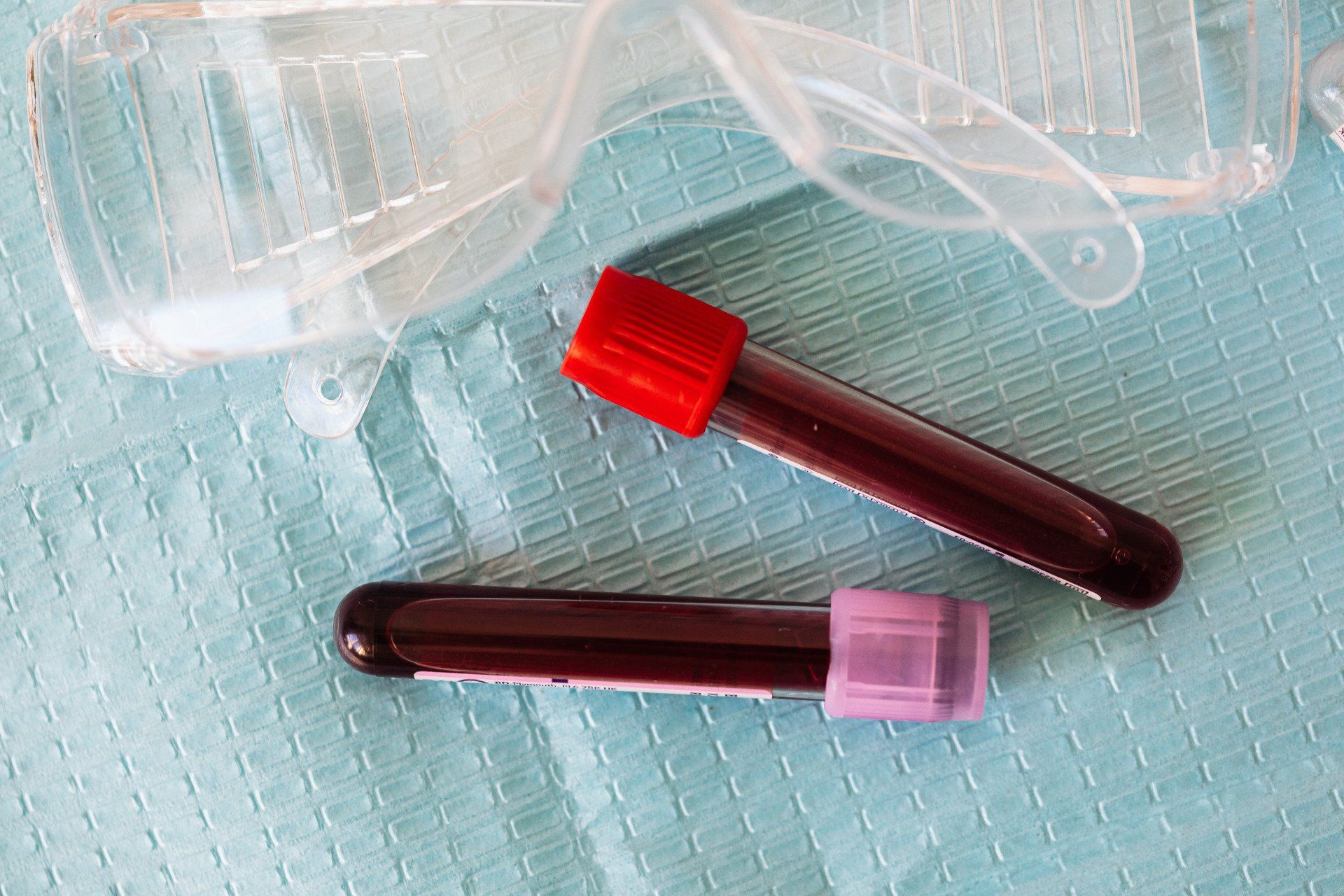Blog
Learn More About
Functional & Integrative Medicine

Discovering the Power Within: The Benefits of Breathwork In our fast-paced and often stressful world, it's easy to forget the incredible power of something as simple as our breath. Yet, throughout history, various cultures have recognized the profound impact that conscious breathing can have on our physical, mental, and emotional well-being. Breathwork, a term used to describe intentional and controlled breathing exercises, has gained popularity in recent years as people seek natural ways to reduce stress, improve their overall health, and unlock their full potential. In this blog, we will explore the numerous benefits of breathwork and how it can be a transformative practice for anyone willing to explore its depths. Stress Reduction One of the most immediate and noticeable benefits of breathwork is its ability to reduce stress and anxiety. Deep, rhythmic breathing activates the body's relaxation response, which helps lower cortisol levels and induces a sense of calm. Whether you're dealing with the pressures of daily life or facing a particularly challenging situation, taking a few minutes to practice breathwork can help you regain control over your emotions and find a sense of inner peace. Improved Mental Clarity Clearing the mental clutter is essential for maintaining focus and making sound decisions. Breathwork techniques such as mindfulness meditation and the 4-7-8 breath (read more on this technique below) can help you achieve mental clarity by promoting a state of mindfulness. When you engage in these practices, you become more present and aware, allowing you to let go of distracting thoughts and concentrate on the task at hand. Enhanced Physical Health The connection between our breath and physical health cannot be overstated. Deep breathing improves oxygenation of the body, leading to better circulation and increased energy levels. Moreover, it aids in digestion, supports the immune system, and can even reduce inflammation. Through regular breathwork, individuals may experience a boost in overall vitality and improved physical well-being. Emotional Release Our emotions are closely tied to our breath, and breathwork provides a safe space to explore and release pent-up emotions. Conscious breathing can help you process and release suppressed feelings, allowing you to experience emotional freedom and a greater sense of inner peace. This aspect of breathwork can be especially valuable for those dealing with trauma or emotional challenges. Enhanced Self-Awareness Breathwork can serve as a gateway to self-discovery. When you focus on your breath, you become more attuned to your body, mind, and emotions. This heightened self-awareness can lead to a deeper understanding of yourself, your thought patterns, and your triggers. As you gain insight into your inner world, you can work towards personal growth and development. Improved Sleep Quality Sleep is vital for our physical and mental well-being, and breathwork can help improve the quality of your sleep. Deep, intentional breathing before bedtime can calm the nervous system, making it easier to fall asleep and stay asleep. Additionally, breathwork can reduce the occurrence of sleep disturbances caused by stress and anxiety. Enhanced Resilience By practicing breathwork regularly, you can develop greater resilience in the face of life's challenges. When you have a toolbox of breathwork techniques at your disposal, you're better equipped to manage stress, anxiety, and difficult situations. This resilience can lead to a more balanced and fulfilling life. Conclusion Breathwork is a powerful and accessible tool that anyone can use to improve their physical, mental, and emotional well-being. Whether you're looking to reduce stress, enhance your mental clarity, or embark on a journey of self-discovery, breathwork offers a range of benefits that can positively impact your life. It's a simple yet profound practice that empowers individuals to harness the incredible power of their breath, paving the way for a healthier, happier, and more resilient self. So, take a deep breath and explore the transformative potential of breathwork – it might just change your life for the better. 4-7-8 Breathing technique: The 4-7-8 breathing technique, also known as "relaxing breath," is a simple and effective breathing exercise that can help reduce stress, promote relaxation, and improve overall well-being. It's often used to calm the mind and body, making it easier to manage anxiety, fall asleep, or regain composure in stressful situations. This technique is based on an ancient yogic practice called pranayama and was popularized by Dr. Andrew Weil, a renowned integrative medicine expert. Here's how to do the 4-7-8 breathing technique: Find a Comfortable Position: Start by sitting in a comfortable chair with your back straight, or you can choose to lie down on your back if that's more comfortable for you. Place the tip of your tongue against the roof of your mouth, just behind your upper front teeth. Keep your lips slightly parted throughout the exercise. Exhale Completely: Take a deep breath in through your nose, filling your lungs to their maximum capacity. Then, exhale completely through your mouth with a gentle whooshing sound. This is the starting point for the 4-7-8 cycle. Inhale Quietly Through Your Nose for a Count of 4: Close your mouth and inhale silently through your nose to a mental count of 4. Try to inhale smoothly and evenly, not rushing or forcing the breath. Hold Your Breath for a Count of 7: After you've completed the 4-second inhalation, hold your breath for a count of 7. During this phase, focus on maintaining stillness and keeping your body relaxed. Exhale Slowly and Completely Through Your Mouth for a Count of 8: Now, exhale slowly and completely through your mouth to a count of 8. As you exhale, release any tension in your body, and let go of any remaining air. Repeat the Cycle: This completes one cycle of the 4-7-8 breathing technique. Now, start again from step 2 and continue the cycle for a total of four breaths. After practicing a few times, you can gradually increase the number of cycles as you become more comfortable with the technique. Tips for Effective Practice: Ensure that your breaths are slow, gentle, and controlled throughout the exercise. Keep your focus on your breath and the counting, which helps redirect your attention away from racing thoughts. It's essential to maintain the 4-7-8 ratio (4 seconds inhale, 7 seconds hold, 8 seconds exhale) for optimal results. Practice this technique at least twice a day or whenever you need to reduce stress or induce relaxation. The 4-7-8 breathing technique can be a valuable tool for managing stress, anxiety, and even improving sleep quality. It's a simple practice that can be done anywhere and anytime you need to find a moment of calm and center yourself.

Circadian health is an intricate but essential aspect of our lives, governing our daily rhythms, sleep patterns, and overall well-being. In this blog, we'll explore the fascinating world of circadian rhythms, their impact on our lives, and practical tips for nurturing your circadian health. Understanding the Circadian Clock Imagine your body as a well-tuned orchestra, with every instrument playing in harmony. This symphony of internal processes, known as circadian rhythms, guides your body through a 24-hour cycle. These rhythms influence everything from your sleep-wake cycle to hormone production and body temperature regulation. The Role of the Suprachiasmatic Nucleus (SCN) At the heart of this intricate orchestra is the suprachiasmatic nucleus, a tiny cluster of cells in the brain's hypothalamus. The SCN acts as the conductor, synchronizing your body's internal rhythms with the external world. Circadian Health and Sleep One of the most prominent roles of circadian rhythms is regulating our sleep-wake cycle. When aligned with your natural circadian rhythm, sleep becomes restorative and refreshing. Tips for a Better Sleep-Wake Cycle: Consistent Sleep Schedule: Go to bed and wake up at the same time every day, even on weekends. Limit Exposure to Artificial Light: Reduce screen time before bedtime and consider using blue light filters on electronic devices. Optimal Sleep Environment: Create a dark, quiet, and cool sleeping space. Circadian Rhythms and Daily Activities Circadian health extends beyond sleep. It affects your energy levels, mood, and cognitive function throughout the day. Enhancing Your Daily Routine: Morning Sunlight: Exposure to natural light in the morning helps reset your circadian clock and boost alertness. Leverage Peak Times: Align demanding tasks with your body's peak energy levels during the day. Afternoon Breaks: Short breaks and outdoor walks can help maintain your energy levels and focus. Nutrition and Circadian Health Believe it or not, what and when you eat can significantly impact your circadian health. The Importance of Meal Timing: Breakfast Kickstart: Eat a balanced breakfast to jumpstart your metabolism and align with your natural circadian rhythm. Time-Restricted Eating: Consider time-restricted eating, where you consume all your meals within a specific window during the day. Late-Night Eating: Avoid heavy meals close to bedtime, as they can disrupt your sleep. Circadian Disruptions and Their Consequences In our modern world, circadian health often faces challenges, such as shift work, jet lag, and excessive screen time at night. Mitigating Circadian Disruptions: Shift Work Strategies: If you work irregular hours, establish a consistent sleep schedule and minimize light exposure during the day. Jet Lag Recovery: Gradually adjust your sleep schedule before traveling to minimize the effects of jet lag. Digital Detox: Reduce screen time at least an hour before bedtime to mitigate the effects of artificial light on your circadian rhythms. Conclusion Circadian health is the invisible thread that weaves through our lives, influencing our sleep, energy, and overall well-being. By understanding and nurturing our circadian rhythms, we can lead healthier, more balanced lives. Remember, the key to circadian health lies in consistency and alignment with your body's natural clock. Small adjustments to your daily routine can yield significant benefits for your physical and mental health. So, embrace the rhythms of nature, prioritize quality sleep, and let your body's internal orchestra play in perfect harmony.

Cold plunges, also known as ice baths or cold-water immersion, involve submerging your body in cold water for a short period of time. This practice has gained popularity due to its many health benefits. Reduced Muscle Soreness and Inflammation: Cold water immersion may help alleviate muscle soreness and reduce inflammation. The cold temperature can constrict blood vessels and reduce blood flow to muscles, which may help decrease muscle damage and inflammation after intense exercise. Improved Recovery: Cold plunges might aid in post-workout recovery by reducing the buildup of lactic acid in muscles and promoting faster clearance of waste products. This could potentially lead to quicker recovery between workouts. Enhanced Circulation: The sudden exposure to cold water can cause blood vessels to constrict (vasoconstriction) and then dilate (vasodilation) when you warm up again. This process may help improve circulation and overall cardiovascular health. Mood Enhancement: Cold water immersion has been associated with the release of endorphins and other "feel-good" neurotransmitters. This can lead to an improved mood, reduced stress, and increased alertness. Boosted Immune System: Some research suggests that cold exposure may stimulate the production of white blood cells and enhance immune function. Cold plunges might also increase levels of certain immune system proteins, potentially helping your body fend off infections. Improved Sleep: Cold therapy may have a positive impact on sleep quality. Exposure to cold water can lead to better regulation of the sleep hormone melatonin, potentially helping you fall asleep more easily and experience deeper sleep. Increased Metabolism: Cold exposure may temporarily increase metabolic rate as your body works to generate heat to counteract the cold. This could potentially contribute to weight management and fat loss. Stress Reduction: Cold immersion triggers the body's stress response, leading to increased production of stress hormones like adrenaline. Over time, this exposure might help your body become more resilient to stress. Skin Health: Cold water exposure can promote skin health by improving blood flow to the skin's surface and promoting nutrient delivery to skin cells. Potential for Injury Prevention: Regular cold plunges might contribute to improved joint mobility and flexibility, potentially reducing the risk of injuries. It's important to approach cold water immersion with caution and under supervision, especially if you have any underlying health conditions. Sudden exposure to extremely cold water can have risks, including shock, hypothermia, and heart-related issues. Always consult with a healthcare professional before incorporating cold plunges into your routine and start with shorter durations and less extreme temperatures to gauge your body's response.

The neutrophil-to-lymphocyte ratio (NLR) is a simple calculation that involves dividing the absolute neutrophil count (ANC) by the absolute lymphocyte count (ALC) in the blood. It is commonly used as a marker of systemic inflammation and immune response. The NLR can be obtained from a complete blood count (CBC) test. Neutrophils are a type of white blood cell that are typically elevated during acute inflammation or infection, while lymphocytes play a crucial role in the immune response and are involved in chronic inflammation and immunosuppression. The NLR provides a ratio between these two cell types and can serve as an indicator of the balance between pro-inflammatory and anti-inflammatory responses in the body. The significance of the NLR lies in its potential as a prognostic marker for various health conditions. It has been extensively studied and found to be associated with outcomes in various diseases, including cardiovascular disease, cancer, infectious diseases, autoimmune disorders, and even in predicting mortality in critically ill patients. A high NLR value suggests an increased neutrophil response and decreased lymphocyte response, which can indicate a state of heightened inflammation or immune dysfunction. This imbalance has been associated with poorer outcomes in several diseases. On the other hand, a low NLR value may indicate a more favorable prognosis, reflecting a stronger immune response and potentially better disease control. It's important to note that while the NLR can be a useful tool in assessing inflammation and predicting outcomes, it should not be considered in isolation. It should be interpreted in the context of the individual's clinical presentation, medical history, and other relevant laboratory and imaging findings. Consulting with a healthcare professional is essential for accurate interpretation and clinical decision-making.

Every cell in your body is encapsulated by a membrane composed of a double layer of phospholipids (a class of fats with water-loving “head” containing phosphate and a water-hating “tail” of fatty acids joined together). The most abundant phospholipid is Phosphatidylcholine (PC). Phosphatidylcholine is the pivotal phospholipid that is prevalent in healthy young cell membranes and as we get older and/or ill this phospholipid becomes damaged or gets replaced with less beneficial lipids. Also, the lipid layer can trap and store many toxins. These toxins can impact cell membrane and mitochondrial function (cells energy production) as well as cellular communication. PC is incorporated into the cell membrane and improves its integrity and serves to improve the transport of nutrients and export toxins across the cell membrane. Phosphatidylcholine is also a good source of choline, which is the main component used for the production of the memory enhancing neurotransmitter, acetylcholine. Phosphatidylcholine is also an excellent fat emulsifier and thus is helpful to improve cholesterol profiles. With oral application (capsules & liquid), only ~5-10% of Phosphatidylcholine reaches the blood stream. The other 90% ends up in the enterohepatic pathway and is almost fully incorporated into the liver cell membrane. While this may be good for the liver, it does not help other parts of the body as much. On the other hand, with intravenous application, 100% of the biologically active PC is distributed throughout the body via the bloodstream. How is it administered? Typically, a 30 minute to one hour infusion of Phosphatidylcholine is given 1-2 times per week. A minimum of 10 treatments of PC are recommended. Standard doses start at 500 mg, then increase to 750 mg, and then up to 2500 mg per infusion. (Sensitive patients or patients with a high toxin burden may elect to do a starting dose of 175 mg, and ramp up more slowly.) Most patients begin to notice significant health benefits between 8 to 10 treatments. This is why we recommend the initial 10 treatments in a 1-2 month timeframe, so that you and your provider can evaluate this therapy benefit in a timely fashion. On average, most patients find peak benefit after an average of 20 treatments. Thereafter, some patients may elect to continue monthly maintenance doses for certain conditions such as high cholesterol, heart disease and/or neurologic conditions like Parkinson’s and MS. Sometimes IV glutathione is given right after PC therapy for additional therapeutic benefit. Why would you want to do this? Chronic illness is associated with poor cell membrane health. This impacts conditions such as vascular (blood flow to heart, brain and extremities) disease, high cholesterol, liver disease, autoimmune disease, mood disorders, migraines and neurodegenerative disorders such as MS, Alzheimer's, Parkinson's, dementia & memory loss. It has also been studied as a novel treatment for steroid-refractory and/or mesalamine-refractory ulcerative colitis. This is also great for Lyme Disease! By replenishing your cell membranes with healthy phospholipids, you can expect improvement in overall cellular function, repair tight junctions in the intestinal lining, as well as improvement in transport of important nutrients into the cell and export common toxic compounds such as heavy metals, organic pollutants and chemicals like PCBs and pesticides out of the cell.

BPC-157 is a peptide that has gained attention for its numerous therapeutic effects, particularly in the field of regenerative medicine. Here are some potential benefits of BPC-157 peptide therapy: Wound Healing : BPC-157 has been studied for its potential to accelerate wound healing. It may stimulate angiogenesis (the formation of new blood vessels) and increase the expression of growth factors that are important for tissue repair. Tissue Regeneration : Research suggests that BPC-157 may promote the regeneration of various tissues, including muscle, tendon, ligament, and bone. This makes it of interest to athletes and individuals recovering from injuries. Gastrointestinal Health : BPC-157 has been investigated for its potential to protect and heal the gastrointestinal tract. It may help with conditions such as inflammatory bowel disease (IBD), peptic ulcers, and gastritis. Anti-Inflammatory Effects : BPC-157 might exhibit anti-inflammatory properties by modulating cytokine levels and reducing oxidative stress. This could have implications for conditions characterized by chronic inflammation. Pain Relief : Some studies suggest that BPC-157 may have analgesic (pain-relieving) effects, possibly by influencing pain receptors or promoting tissue repair that reduces pain over time. Joint Health : Due to its potential to support tissue regeneration, BPC-157 has been explored for its effects on joint health. It may help improve conditions like osteoarthritis and other joint-related issues. Neuroprotection : Preliminary research indicates that BPC-157 might have neuroprotective properties, potentially benefiting conditions involving nerve damage or neurological disorders. If you are inrerested in learning more about BPC-157 and other peptide therapies, check out the book

What is Semaglutide? It belongs to a class of drugs known as GLP-1 receptor agonists. GLP-1 (glucagon-like peptide-1) is a hormone that helps regulate blood sugar levels by increasing insulin release, decreasing glucagon secretion, slowing down gastric emptying, and promoting a feeling of fullness. In recent years, semaglutide has gained attention for its potential use as a weight loss medication. Novo Nordisk, the pharmaceutical company that developed semaglutide, conducted clinical trials to assess its efficacy for weight loss in individuals without diabetes. The brand name for the weight loss formulation of semaglutide is "Wegovy." Benefits of semaglutide for weight loss: Significant Weight Loss: Clinical trials have shown that semaglutide can lead to substantial weight loss compared to placebo. Some individuals have lost over 10% of their body weight. Metabolic Improvements: Semaglutide can lead to improvements in various metabolic parameters, including reduced blood sugar levels, improved insulin sensitivity, and decreased blood pressure. Appetite Suppression: GLP-1 receptor agonists like semaglutide can reduce appetite and increase the feeling of fullness, which can contribute to weight loss. Cardiovascular Benefits: Some studies suggest that GLP-1 receptor agonists may have cardiovascular benefits, including reducing the risk of heart disease. Risks and considerations: Gastrointestinal Side Effects: Semaglutide can cause gastrointestinal side effects such as nausea, vomiting, and diarrhea, especially when starting treatment. These side effects can be uncomfortable and may lead to discontinuation of the medication. Pancreatitis: GLP-1 receptor agonists have been associated with a potential risk of pancreatitis (inflammation of the pancreas). While the risk is generally low, it's important to monitor for any signs of pancreatitis. Thyroid C-Cell Tumors: In animal studies, semaglutide has been shown to increase the risk of thyroid C-cell tumors. However, the relevance of this finding to humans is still under investigation. Cost and Long-Term Safety: As with any new medication, the long-term safety of semaglutide for weight loss needs further evaluation. Additionally, the cost of the medication might be a limiting factor for some individuals. Individual Variation: The effectiveness of semaglutide for weight loss can vary from person to person, and not everyone may experience significant weight loss. Before considering semaglutide or any other medication for weight loss, it's important to consult with a healthcare provider. They can assess your individual health profile, discuss potential risks and benefits, and help you make an informed decision about the best approach to managing your weight.

Iron-deficiency anemia is a condition where the body lacks sufficient iron to produce enough hemoglobin, a protein in red blood cells that carries oxygen throughout the body. This can lead to a variety of symptoms. Here are some common symptoms of iron-deficiency anemia: Fatigue: Feeling unusually tired or weak, even with adequate rest. Pale skin: A noticeable paleness in the skin, particularly in the face, nails, and lining of the eyes. Shortness of breath: Difficulty breathing or increased breathlessness, especially during physical activity. Dizziness or lightheadedness: Feeling faint or dizzy, particularly when standing up quickly. Headaches: Frequent or persistent headaches, sometimes accompanied by dizziness. Cold hands and feet: Reduced circulation can lead to extremities feeling cold. Brittle nails: Nails that may become concave or spoon-shaped and are more prone to breaking. Swelling or soreness of the tongue: Tongue inflammation or swelling (glossitis) may occur. Pica: Craving and chewing on non-food items such as ice, dirt, or paper. If you suspect you have iron-deficiency anemia or are experiencing any of these symptoms, it's essential to consult a healthcare professional for proper diagnosis and treatment. They may perform a blood test to measure your hemoglobin levels and check for anemia. Treatment options for iron-deficiency anemia generally focus on increasing iron levels in the body. Some common treatment approaches include: Iron supplements: Iron supplements in the form of tablets, capsules, or liquids are often prescribed to increase iron levels. They should be taken as directed by a healthcare provider. Dietary changes: Consuming iron-rich foods can help improve iron levels. Good sources of iron include red meat, poultry, fish, beans, lentils, tofu, spinach, fortified cereals, and dried fruits. Vitamin C intake: Vitamin C can enhance iron absorption, so consuming foods rich in vitamin C alongside iron-rich foods or supplements may be beneficial. Blood transfusion: In severe cases where iron levels are dangerously low or when there is significant blood loss, a blood transfusion may be necessary. Treating the underlying cause: Addressing any underlying conditions that lead to blood loss or hinder iron absorption, such as gastrointestinal disorders or heavy menstrual bleeding, can be crucial in managing iron-deficiency anemia. It's important to note that self-diagnosis and self-treatment are not recommended. Always seek advice from a healthcare professional to determine the appropriate treatment plan based on your specific condition and medical history.

Optimal testosterone levels are important for men's overall health and well-being due to the numerous roles that testosterone plays in the body. Testosterone is a key hormone that affects various aspects of physical, mental, and sexual health. Here are some reasons why maintaining optimal testosterone levels is important for men: Sexual Health and Libido : Testosterone is a primary driver of male sexual desire (libido) and plays a crucial role in achieving and maintaining erections. Low testosterone levels can lead to decreased interest in sex and difficulties with sexual performance. Muscle Mass and Strength : Testosterone is essential for the development and maintenance of lean muscle mass. It helps with protein synthesis and the growth of muscle tissue, which is important for physical strength and overall body composition. Bone Health : Testosterone is involved in the maintenance of bone density and strength. Low testosterone levels can contribute to decreased bone mineral density, increasing the risk of osteoporosis and fractures. Energy and Vitality : Adequate testosterone levels are associated with higher energy levels, better mood, and an overall sense of vitality. Low testosterone can lead to fatigue, irritability, and decreased motivation. Cognitive Function : Testosterone has an impact on cognitive functions such as memory, attention, and spatial abilities. Maintaining optimal levels may contribute to better cognitive performance. Red Blood Cell Production : Testosterone stimulates the production of red blood cells in the bone marrow. This helps maintain proper oxygen delivery to cells and tissues throughout the body. Metabolic Health : Testosterone can influence metabolism and insulin sensitivity. Low testosterone levels have been linked to obesity and an increased risk of developing type 2 diabetes. Mood Regulation : Adequate testosterone levels are associated with better mood and reduced risk of depression. Low testosterone levels can contribute to mood swings, irritability, and feelings of sadness. Facial and Body Hair Growth : Testosterone is responsible for the growth of facial and body hair during puberty and beyond. Low testosterone levels might lead to a reduction in facial and body hair growth. Cardiovascular Health : Some studies suggest a link between low testosterone levels and cardiovascular risk factors, such as increased cholesterol levels and higher blood pressure. Maintaining healthy testosterone levels might contribute to better cardiovascular health. It's important to note that testosterone levels naturally decline with age, typically starting around the age of 30. This is a normal part of the aging process, but for some men, the decline can be more significant and lead to symptoms associated with low testosterone. If you suspect you have low testosterone or are experiencing symptoms, it's advisable to consult a healthcare professional for proper evaluation, diagnosis, and treatment options.

Akkermansia muciniphila is a type of bacteria that naturally resides in the human gut. It has gained a lot of attention in recent years due to its potential importance for gut health. While research on Akkermansia is ongoing, here are some reasons why it is considered important: Mucus Layer Maintenance: Akkermansia muciniphila is known to thrive on the mucin layer that lines the gut, particularly the mucin produced by the epithelial cells in the intestinal lining. This bacterium helps to maintain the integrity and thickness of the mucus layer, which serves as a protective barrier between the gut's epithelial cells and the gut contents. A healthy mucus layer is crucial for preventing harmful substances from coming into direct contact with the intestinal cells and for supporting gut barrier function. Gut Barrier Function: A healthy gut barrier is essential for preventing the leakage of harmful substances, such as toxins and undigested food particles, from the intestines into the bloodstream. Akkermansia muciniphila contributes to the maintenance of the gut barrier by promoting the production of tight junction proteins that hold intestinal cells together, thus preventing the entry of harmful substances. Metabolic Health: Research suggests that individuals with a higher abundance of Akkermansia muciniphila in their gut tend to have a healthier metabolic profile. This bacterium has been associated with improved insulin sensitivity, reduced inflammation, and better glucose metabolism. These factors are crucial for reducing the risk of metabolic disorders like obesity and type 2 diabetes. Anti-Inflammatory Effects: Akkermansia muciniphila has been linked to reduced levels of inflammation in the gut and the body. Chronic inflammation in the gut is associated with various health issues, including inflammatory bowel diseases (IBD) like Crohn's disease and ulcerative colitis. By helping to maintain a balanced inflammatory response, Akkermansia may contribute to gut health and overall well-being. Diversity of Gut Microbiota: A diverse and balanced gut microbiota is generally associated with better health outcomes. Akkermansia muciniphila plays a role in maintaining this diversity by interacting with other bacteria and influencing the composition of the gut microbiota. A more diverse microbiota is often linked to improved digestion, nutrient absorption, and overall gut function. It's important to note that while Akkermansia muciniphila shows great promise for gut health, it's just one of many factors that contribute to a healthy gut microbiome. A balanced diet rich in fiber, prebiotics, and a variety of nutrients, as well as a generally healthy lifestyle, are also essential for promoting optimal gut health. Additionally, the field of microbiome research is still evolving, and new insights into the roles of specific bacteria continue to emerge.

